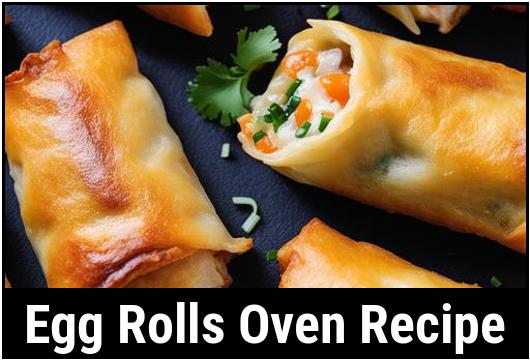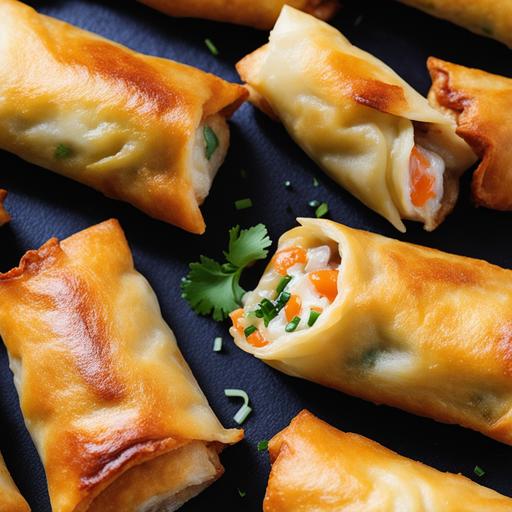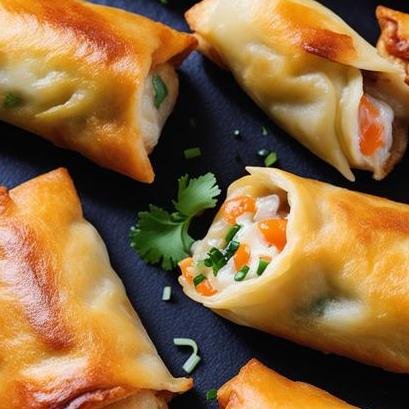
The Art Of Making Perfect Egg Rolls: An Oven Recipe Masterclass
Egg rolls are a delightful culinary creation that trace their roots back to Chinese cuisine. These crispy bundles of joy are filled with a savory mixture of vegetables, aromatics, and proteins, all wrapped in a thin pastry shell. While traditionally deep-fried, we are here to demystify the process of creating egg rolls using the convenience of an oven. In this comprehensive guide, we will delve into the food science behind egg rolls, discuss culinary details, selection, cleaning, preparation, offer helpful tips and variations, teach you doneness checks, and provide you with a foolproof oven recipe. Let’s get rolling!
The Science of Egg Rolls
Understanding the food science behind egg rolls is essential to achieve the perfect result. The primary purpose of the egg roll wrapper is to hold the filling together while creating a crispy texture. The pastry shell, usually made from flour, water, and salt, turns golden and crispy during baking due to the Maillard reaction. The Maillard reaction occurs between the proteins and sugars in the dough, resulting in a complex blend of flavors and a visually appealing golden-brown color.
Culinary Details: Selecting the Right Ingredients
To create a flavorful and satisfying egg roll, it is crucial to carefully select quality ingredients. Consider the following tips when choosing your ingredients:
-
Egg Roll Wrappers: These can be found in most Asian grocery stores or well-stocked supermarkets. Opt for fresh, pliable wrappers that are not brittle or dried out.
-
Vegetables: Choose a selection of fresh and crispy vegetables for your filling. Classic choices include cabbage, carrots, bean sprouts, and scallions. Ensure that the vegetables are free from any signs of spoilage.
-
Protein: Select a protein of your choice to add depth to the filling. Popular options include cooked shredded chicken, diced shrimp, ground pork, or tofu for a vegetarian twist.
-
Aromatics: Enhance the flavors by using aromatics such as ginger, garlic, and onion. Freshly minced or grated aromatics will give your filling a more pronounced taste.
Cleaning and Preparation: A Fresh Start

Before diving into the preparation process, it is crucial to clean and prepare your ingredients to promote food safety and enhance the overall taste. Follow these guidelines:
-
Wash and Chop Vegetables: Thoroughly rinse vegetables under cool running water to remove any dirt or impurities. Pat them dry using a clean kitchen towel and proceed to finely chop or shred them.
-
Marinate Protein: If using protein, marinate it with your desired seasonings to infuse flavors into the filling. Allow it to rest for a few minutes before cooking or baking.
-
Mince Aromatics: Finely mince or grate the ginger, garlic, and onion to release their aromatic compounds, ensuring even distribution of flavors throughout the filling.
Tips and Tricks: Achieving the Perfect Egg Roll

Creating delicious and perfectly cooked egg rolls requires attention to detail. Here are some essential tips and tricks to guide you:
-
Preheat the Oven: Ensure your oven is preheated to the recommended temperature before baking your egg rolls. This guarantees even heat distribution and promotes a crisp exterior.
-
Avoid Overfilling: While it can be tempting to pack the filling tightly, overfilling can lead to a soggy and undercooked center. Aim for a moderate amount of filling to maintain an optimal texture.
-
Roll Tightly: The key to a well-formed egg roll lies in a tight roll. Start by folding the bottom corner of the wrapper over the filling, followed by folding the sides. Roll the wrapper tightly towards the opposite corner while applying gentle pressure to secure the roll’s shape.
-
Seal with Egg Wash: To create a secure seal and prevent unraveling, brush a thin layer of beaten egg onto the exposed corner of the wrapper before finishing the roll. The egg acts as an adhesive when baked.
-
Proper Placement: Arrange the egg rolls on a baking sheet, leaving sufficient space between them to promote even browning. Avoid overcrowding, which can result in steaming instead of crisping.
A Foolproof Oven Recipe: Getting Started

Now that you are equipped with the necessary knowledge and tips, it’s time to put it all into action with this reliable oven recipe for egg rolls:
Ingredients:
-
12 egg roll wrappers
-
2 cups shredded cabbage
-
1 cup grated carrots
-
1 cup bean sprouts
-
½ cup diced onions
-
½ cup diced cooked chicken (or protein of choice)
-
2 cloves garlic, minced
-
1 tablespoon grated ginger
-
2 tablespoons soy sauce
-
1 teaspoon sesame oil
-
Salt and pepper to taste
-
Beaten egg for sealing
Instructions:
-
Preheat your oven to 400°F (200°C) and line a baking sheet with parchment paper.
-
In a large bowl, combine the shredded cabbage, grated carrots, bean sprouts, diced onions, diced cooked chicken, minced garlic, and grated ginger. Mix well.
-
In a smaller bowl, whisk together the soy sauce, sesame oil, salt, and pepper. Pour the mixture over the vegetable and protein mixture, tossing until evenly coated.
-
Place an egg roll wrapper on a clean work surface, with one corner facing towards you. Spoon approximately 2 tablespoons of the filling onto the center of the wrapper in a rectangular shape.
-
Fold the bottom corner of the wrapper over the filling, then fold in the sides. Roll the wrapper tightly towards the opposite corner, applying gentle pressure to secure the roll. Brush the exposed corner with beaten egg to seal.
-
Place the sealed egg roll on the prepared baking sheet. Repeat the process with the remaining wrappers and filling.
-
Bake the egg rolls in the preheated oven for 18-20 minutes, or until they turn golden brown and crispy.
-
Once cooked, remove the egg rolls from the oven and let them cool for a few minutes before serving alongside your favorite dipping sauce.
Doneness Checks: Ensuring Perfection

Determining the doneness of your egg rolls is crucial to achieve a crispy exterior with a cooked-through filling. Here are two methods to check for doneness:
-
Visual Check: Ensure the egg rolls are golden brown and exhibit an even color throughout. A pale or undercooked appearance may indicate that further baking is required.
-
Internal Temperature: For added accuracy, you can use a meat thermometer to check the internal temperature of the filling. It should read at least 165°F (74°C) to ensure any proteins used are fully cooked.
Overcooking and Undercooking: Avoiding Common Pitfalls
While striving for perfection, it’s essential to be aware of common pitfalls that may occur during the baking process. Here’s how to avoid overcooking and undercooking your egg rolls:
-
Overcooking: Overcooking can result in dried-out egg rolls with an overly darkened exterior. Ensure you closely monitor the oven temperature and baking time, removing the egg rolls as soon as they turn golden brown.
-
Undercooking: On the other hand, undercooked egg rolls may have a raw or soggy interior. To prevent this, maintain the recommended oven temperature and bake the rolls for the full suggested time, making sure they are thoroughly cooked and crisp.
Variations: Unleashing Creativity
While the classic egg roll recipe is undoubtedly delicious, feel free to explore various flavor combinations and alternative ingredients. Here are some popular variations to inspire your creativity:
-
Vegetarian Egg Rolls: Replace the protein with tofu or mushrooms and experiment with different vegetables like bell peppers or zucchini.
-
Spicy Egg Rolls: Add a kick to your filling by incorporating diced jalapeños or a dash of sriracha sauce. Adjust the spice level to suit your taste preferences.
-
Fusion Egg Rolls: Infuse your egg rolls with flavors from different culinary traditions. For example, try adding Thai basil and a hint of fish sauce for a Southeast Asian twist.
Conclusion
With this comprehensive guide, you are now equipped with the knowledge, tips, and a foolproof oven recipe to create egg rolls that are crispy, flavorful, and cooked to perfection. Whether you enjoy them as an appetizer, snack, or main course, egg rolls are a delightful addition to any menu. So gather your ingredients, preheat that oven, and embark on your egg roll-making adventure – there’s a world of flavor waiting to be discovered!
Sources
FAQS On Egg Rolls Oven Recipe
Can I Use Egg Roll Wrappers From The Store For This Oven Recipe?
Yes, you can use store-bought egg roll wrappers for this recipe. Just make sure to follow the manufacturer’s instructions for thawing and handling the wrappers.
Can I Freeze The Uncooked Egg Rolls For Later?
Yes, you can freeze the uncooked egg rolls for later. Simply wrap them tightly in plastic wrap and aluminum foil to prevent freezer burn. When you’re ready to cook them, remove from the freezer and let them thaw in the refrigerator for several hours before baking.
How Long Does It Take To Bake Egg Rolls In The Oven?
Baking time can vary based on your oven and the size of your egg rolls. Typically, it takes around 20-25 minutes to bake egg rolls in a preheated oven at 375°F. Make sure to check them frequently, as the edges can burn easily.
What Dipping Sauce Goes Well With Egg Rolls?
Egg rolls are traditionally served with sweet and sour sauce, but you can also try dipping them in soy sauce, hoisin sauce, or spicy mustard sauce.
Can I Make Vegetarian Egg Rolls Using This Recipe?
Absolutely! You can substitute the meat with tofu or shredded vegetables such as cabbage, carrots, and onions. Just make sure to season the filling well with spices and herbs for flavor.



